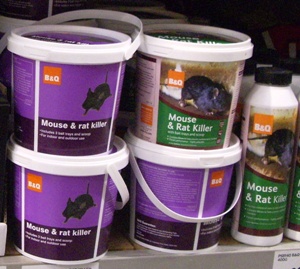Whilst at PestEx, the Chemicals Regulation Directorate (CRD) released (on 6 April) for consultation with approval holders its proposals for the usage of rodenticide bait products. These cover restricting products for professional use only, pack sizes, the use of tamper resistant bait boxes and bait box servicing intervals.
Although only a consultation document this clearly shows the direction CRD is proposing for the future. If adopted, these new requirements will require significant amendments as to how practical rodent pest control is undertaken.
|
Readers will already be aware (see Pest issue 12 – click here) that eight anticoagulant active substances (difethialone, difenacoum, coumatetralyl, warfarin, chlorophacinone, bromadiolone, brodifacoum and flocoumafen) have been voted onto Annex I of the Biocidal Products Directive (BPD). But, unlike other biocidal products, some decisions on risk mitigation measures, rather than being agreed on a pan-European basis, have been ‘deferred’ to product authorisation at national level. This approach does therefore allow flexibility between countries. Pack sizes and bait boxes |
|
|
|
For non-professional (amateur) users it is proposed that rat and mouse bait should be applied only in commercially available tamper-resistant bait stations (either prefilled or refillable) or for mice only in covered bait points. Bait should be supplied in inner packs or units, each containing enough bait for one bait point (either rat or mouse). The whole pack should contain at most 1.5 kg bait (i.e. enough bait to control a single infestation). Bait box servicing intervals Under COPR there was no statutory maximum time interval between visits to rodenticide bait points and this led to confusion among product users, as well as householders and companies engaging pest controllers. Taking into consideration the current state of knowledge regarding rodenticide efficacy and issues of practicability in pest controllers visiting and gaining access to baits (such as those placed in private households and sewers) it is proposed for both professional and non-professional users that:
The initial response expressed by members of the pest control industry revolve around the frequency of bait box visitations. No longer will servicing companies be able to simply offer the ‘eight visits a year’ type contract. And not being able to use anticoagulant baits for longer than 35 days is a radical departure from current permanent outdoor baiting practice – a practice frequently demanded by customers, particularly within the food industry. Another gripe is, yet again, there is no definition provided as to who is a ‘professional.’ The flexibility to apply baits in formats other than exclusively in tamper resistant bait boxes (in covered bait points or in open trays) is a major triumph for common sense – unlike the position in the USA and also within certain EU member states. Commenting on these proposals, Dr Alan Buckle from the University of Reading said: “CRD has obviously put much thought into these proposals and has also taken the time and trouble to consider the practical implications. Overall the recommendations seem very sensible.” It is worth noting, that this current document does not address risk mitigation measures which might be proposed by the UK to protect non-target animals and the environment. Any such environmental risk mitigation measures, such as restrictions on outdoor use, will be in addition to the human health risk mitigation measures proposed here and are likely to follow at a later date. The deadline for comments on these proposals is 2 May 2011. Trade associations will be gathering replies as will approval holders. Alternatively you can make your views known by emailing CRD – click here – and add “BPR Rodenticide Consultation” in the subject line. |
||


